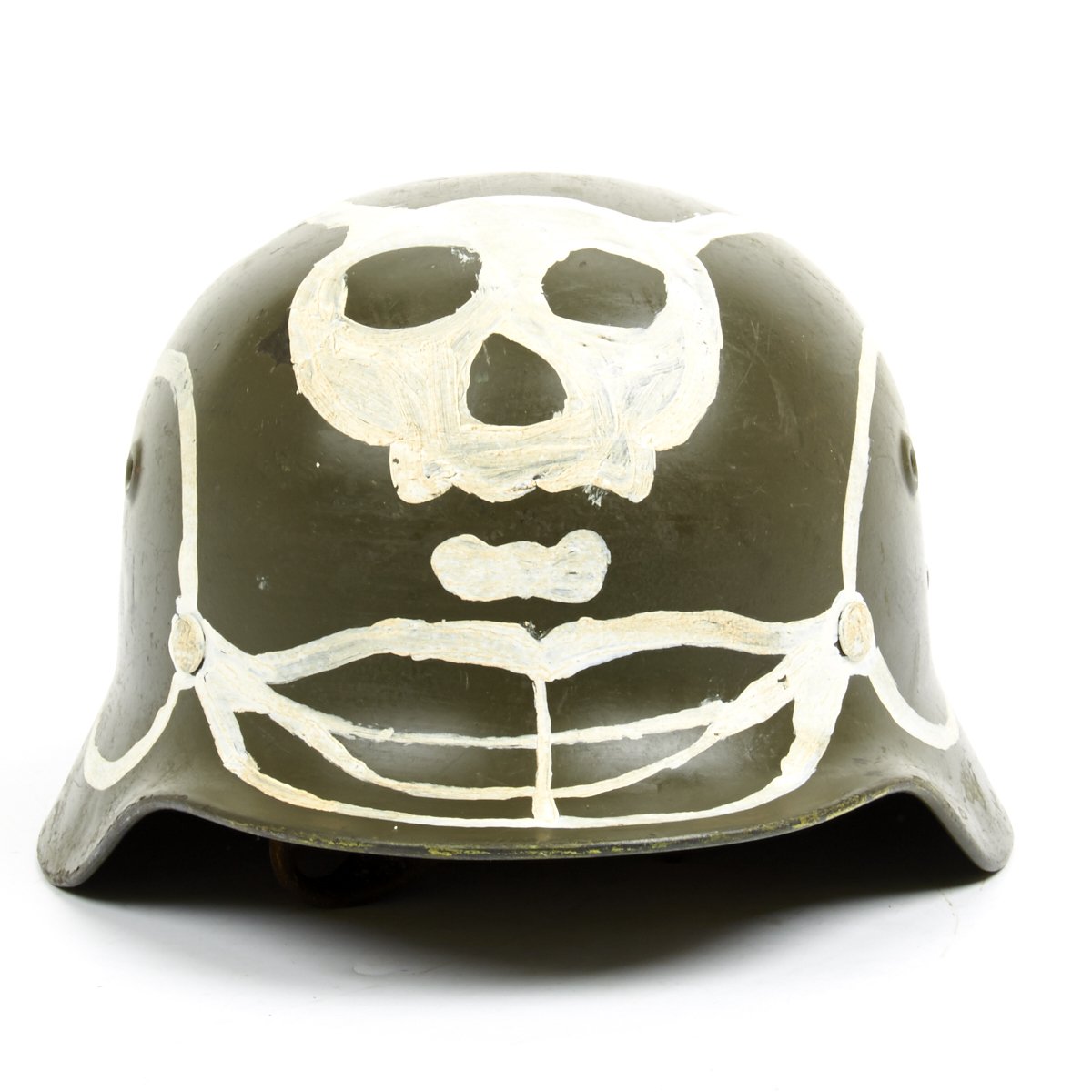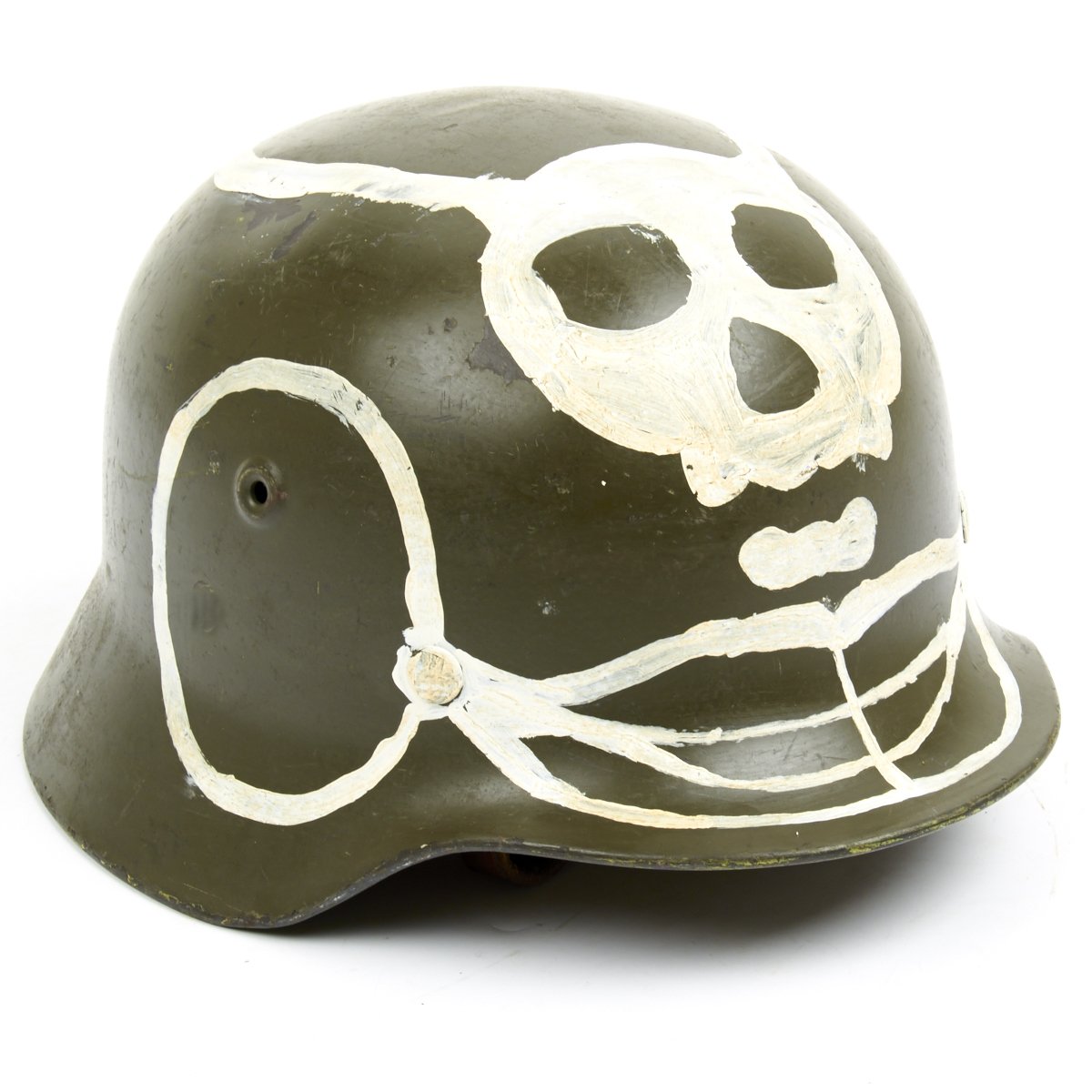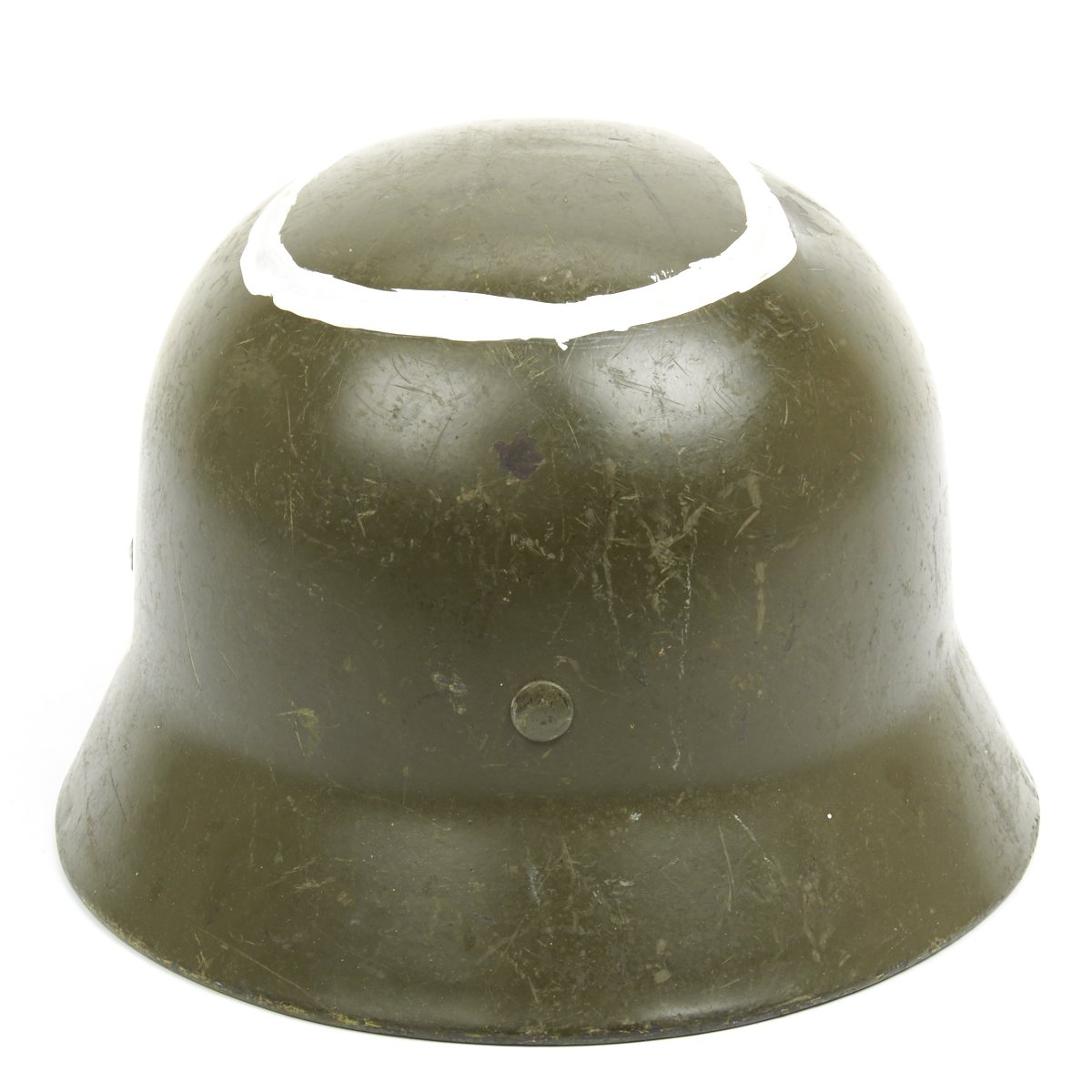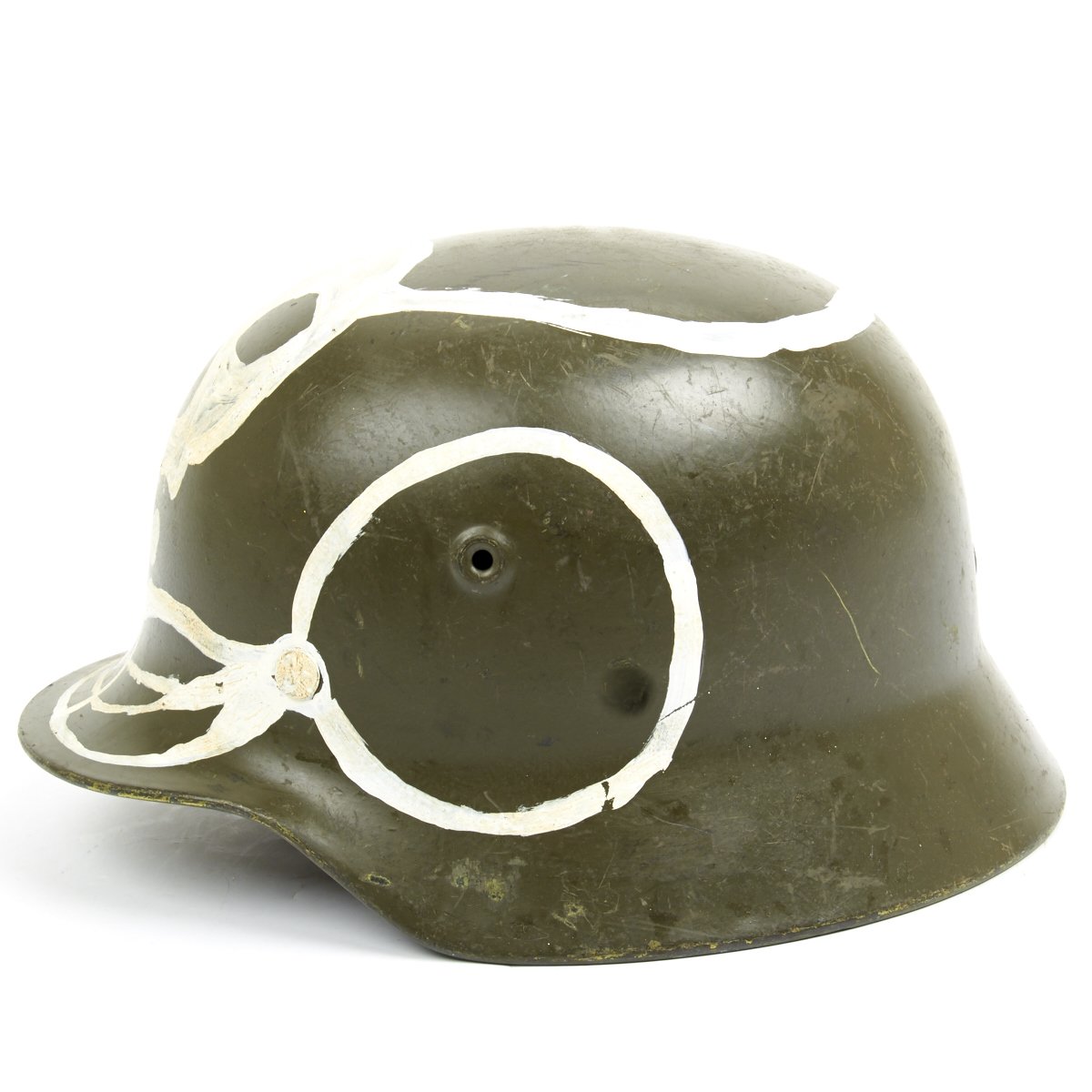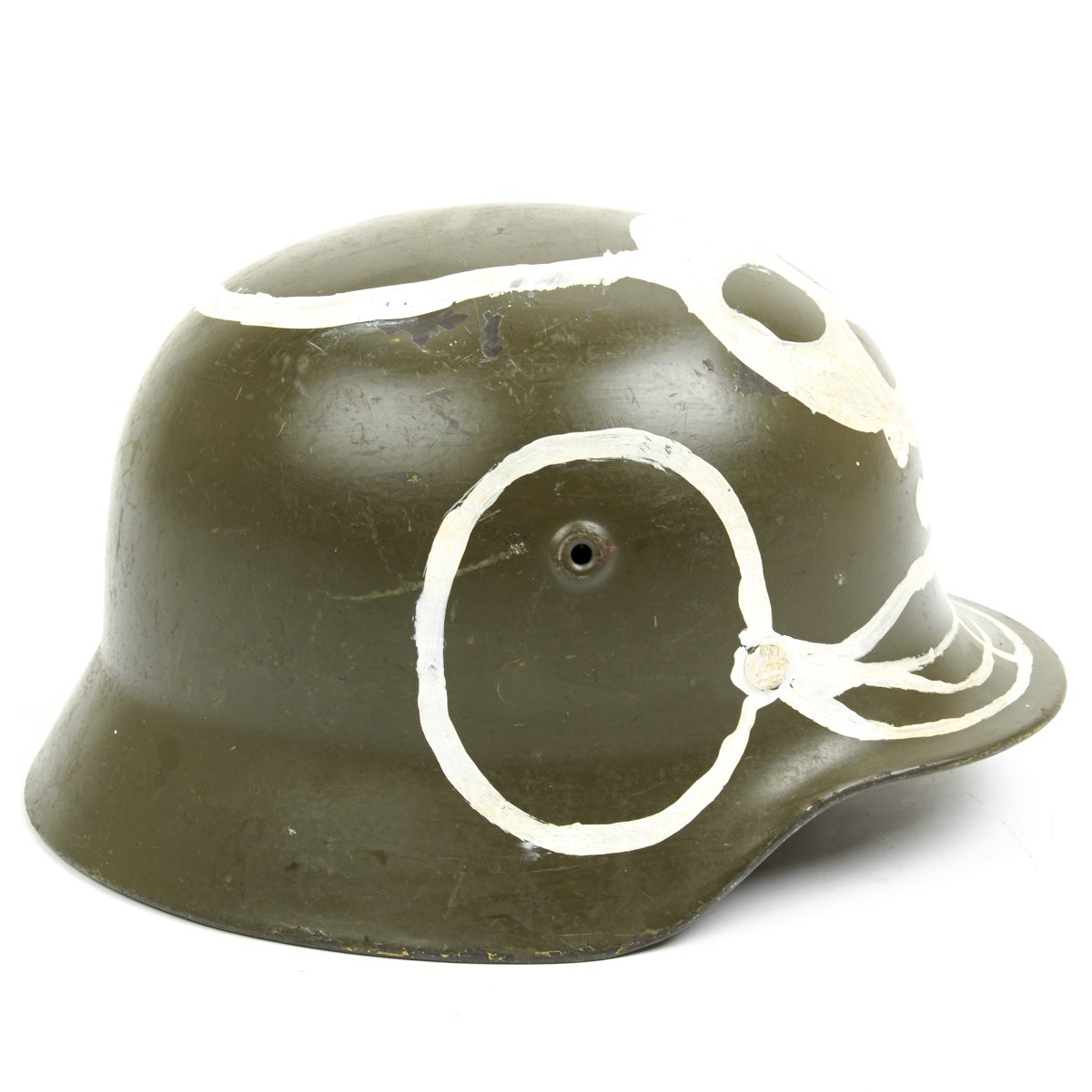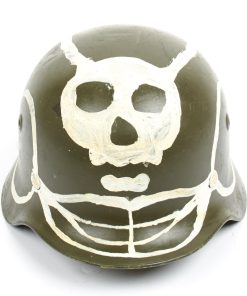Original Finnish M40/55 Helmet with Winter War Skull – Finnish 4th Division KevOs4 Original Items
$ 69,95 $ 34,98
Original Item: In another military antiques coup, IMA has just acquired the last of all the known WWII helmet stocks from the government of Finland. These helmets are 100% genuine German manufactured WWII type M40 steel combat helmets that were produced by German WWII helmet manufacturer Hans Römer Fabrik from Neu-Ulm (Donau-Freiberg).
While the helmets are totally genuine the Painted Skull & Bones has been newly replicated. Be sure to see the period photograph of the Finnish 4th Division, Kev Os. 4 (Light Unit Number 4) whose primary role was armed reconnaissance to protect the main infantry body. Kev Os.4 (4th Kevyt Osasto) rapidly acquired the nickname Belaya Smjert, or “White Death,” from their Soviet opponents in the 1939–1940 Winter War between Finland and the USSR following a series of deadly hit and run attacks by the unit’s highly mobile ski troops. The members of Kev Os. 4 enthusiastically adopted the nickname, with many painting a skull and bones on their helmet fronts to further terrify their enemies. Despite inflicting terrible losses on the invading Soviets, the Finns had lost the Winter War by March, 1940. The Finns would later join the Axis forces in their June, 1941 invasion of the Soviet Union, hoping to recover territory lost in the previous treaty with Moscow. The skull painted helmets went with them, as the Germans continued to supply the Finns with helmets throughout most of the Second World War. An important relic of Finnish courage and determination.
Supplied throughout WWII and then under special contract for the Finnish Army in 1955, hence, they have become known as the M40/55 helmet. However, these helmets were made in the same factory, on the same machines and by some of the very same people that produced them for Germany in WWII. They are nearly identical to WWII issue M40s, (and are often sold as such) with the classic rolled edge, correct steel thickness, and pressed ventilation holes. Furthermore, we have very good reason to believe that some of these shells are “sanitized” German WWII M35 and M40 helmets; meaning some are genuine WWII shells that had all stampings rubbed out and original paint removed to avoid the allied ban on West Germany selling war materiel after WW2.
Styles and colors (Field Grey, Field Green) may vary slightly so please see photos for variation examples. Each helmet is offered in good to very good condition, but will show storage wear, minor paint chips and scratches, and occasionally a small ding but all are free of major dents or imperfections. After all, these are real military helmets that were used by actual soldiers in the defense of their country.
The leather liners and chinstraps were made in Finland for the Finnish army who called it the M55 helmet; styles vary, as some of the helmets were used up until the early 1970s. Some of these may also have required drilling additional liner holes in the helmet. The shells do however, accept our splendid reproduction M35 WWII leather helmet liner and chinstrap with reproduction WW2 split pin and washer sets. For installation of a WWII reproduction German liner please be aware that drilling new front holes in liner, not the shell, might be required in some cases.
Sizing- we offer a range of sizes, but we sell these helmets based on the interior liner size, not shell size. However, a general rule of thumb is; size 55/56cm liners are usually inside size 62 shells, size 57/58cm liners are usually inside size 64/66 shells, and size 59cm and above liners are 66/68 shells. We cannot honor requests for specific shell sizes; we only honor requests for liner size. Please make sure you measure your helmet prior to ordering a WWII Style German M-31 liner, as the Finnish liners are more low profile than the German style. Most likely you will need to get a smaller size liner than the one in the helmet.
This is a rare chance to own a genuine military issue German made M40 WWII style helmet for the almost the same price as a Chinese or Indian made reproduction. There is simply no comparison to a genuine combat helmet!
History of Finnish Combat Helmets-
Finland imported tens of thousands of helmets for the Winter War of 1939-40 and the Continuation War of 1941-44, and imported again in 1955. Since IMA acquired the last of all the known helmet stock from the Finnish government you may wonder did we get German WWII marked helmets? Yes, and they will be offered at a far higher price. Did we get other types of helmets? Yes, we also received Hungarian WWII M38 (1938) helmets as well. This deal is a treasure trove of WWII era combat helmet history.
History the German & Finnish Alliance-
In 1938 Finland became very concerned with Stalin’s Soviet expansionism and turned to Great Britain and France for support. Both Countries were under supplied themselves so Finland, perhaps reluctantly turned to NSDAP Germany for aid. AH was swift to assist supplying great quantities of materiel including thousands of German Battle Helmets.
The Russians invaded Finland in 1939 driving deep into the country. The Finns resisted with amazing tenacity that has been the subject of legend and the wonderful WW2 Movie “THE WINTER WAR” (offered by IMA). The Russians paid a very heavy price and sued for peace in early 1940 keeping the invaded areas of Finland. Finland totally exhausted agreed with great regret.
In the summer of 1941 AHs NSDAP War Machine invaded the Soviet Union driving everything before them. Finland whom had received so much help from Germany then rose up and drove the Soviet presence out of Finland. However Finland would not “invade” the Soviet Union, they declared themselves not to be aggressors.
It is true however that the Germans recruited great numbers of Finnish “Volunteers” for their “SS UNITS” that did invade Mother Russia but that was true of all the overrun European Countries and even some others, still independent including apparently England and the United States, although these number were said to be very low.
At the close of WW2 with Germany defeated Finland was highly penalized by the Soviet Union, again gave up the lost territory of 1939/40 but did manage to retain it’s independence unlike so much of Eastern Europe.
| Hand Select | No, Yes |
|---|---|
| Size | 6.85 (55 cm), 7 (56 cm), 7 1/8 (57 cm), 7 1/4 (58 cm), 7 3/8 (59 cm), 7 1/2 (60 cm) |
Fast Shipping with Professional Packaging
Thanks to our longstanding association with UPS FedEx DHL, and other major international carriers, we are able to provide a range of shipping options. Our warehouse staff is expertly trained and will wrap your products according to our exact and precise specifications. Prior to shipping, your goods will be thoroughly examined and securely secured. We ship to thousands clients each day across multiple countries. This shows how we're dedicated to be the largest retailer on the internet. Warehouses and distribution centres can be located throughout Europe as well as the USA.
Note: Orders with more than one item will be assigned a processing date depending on the item.
Before shipping before shipping, we'll conduct a thorough inspection of the items you have ordered. Today, the majority of orders will be delivered within 48 hours. The delivery time will be between 3-7 days.
Returns
The stock is dynamic and we cannot completely manage it because multiple stakeholders are involved, including our factory and warehouse. So the actual stock may alter at any time. It's possible that you may not receive your order once the order has been made.
Our policy is valid for a period of 30 days. If you don't receive the product within 30 days, we are not able to issue a refund or an exchange.
You can only return an item if it is unused and in the same state as the day you received it. You must have the item in its original packaging.
Related products
Uncategorized
Uncategorized
Uncategorized
Uncategorized
Uncategorized
Armored Burgonet Helmet & Polearm from Scottish Castle Leith Hall Circa 1700 Original Items
Uncategorized
Uncategorized
Uncategorized
Uncategorized
Uncategorized
Uncategorized
Uncategorized
Uncategorized
Uncategorized
Uncategorized
Armoured Fighting Vehicles of the World: AFVs of World War One (Hardcover Book) New Made Items
Uncategorized
Uncategorized

